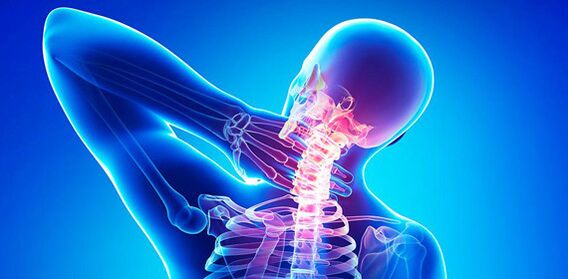
causes of neck pain
- Cervical osteochondrosis, complicated by disc herniation or herniation. The most common and important cause of neck pain. The pain is associated with a partially or completely destroyed disc compressing a spinal nerve root. The pain is very intense, sudden, and may be limited to the neck (on one or both sides) or radiate to other areas - head, back of the head, arms, back, under the shoulder blades, etc. Treatment includes pain management, disc cartilage tissue repair, and neck muscle strengthening. Sometimes such patients require the help of a neurosurgeon to remove the damaged disc.
- Ankylosing spondylitis (rheumatoid spondylitis, ankylosing spondylitis) is an autoimmune inflammatory process of the cervical joints. The disease usually develops gradually and inconspicuously, spreading from bottom to top along the spine. The neck area is the last area to be affected. It manifests as pain in the neck, stiffness of movement, which disappears after starting physical activity. Over time, the pain worsens and the spine becomes immobile. Long-term treatment with a rheumatologist can help.
- Arthropathy of the cervical facet joints (non-spondyloarthrosis). In this case, the cause of pain in the neck and back of the head is degenerative dystrophic changes in the facet joints that connect the cervical spine. Usually has occupational roots, occurs while working in a stationary position with the head bowed or turned vigorously, or after an injury. Symptoms: pain at the affected area, radiating to the shoulder, creaking when moving, sometimes headache, dizziness, high or low blood pressure, and hearing impairment. Treatment is by a neurologist and rheumatologist.
- Torticollis is a change in the position of the neck that results in an inability to turn and make other movements of the head. It can be congenital (in children) and acquired (in adults), and its background is rough skin scarring, degenerative dystrophy of the spine and surrounding soft tissues, and persistent spasms of the neck and occipital muscles in an inflammatory process. Symptoms: Head tilt and shoulder elevation on the affected side, pain in the neck and back of the head when trying to tilt the head in the opposite direction. The pain worsens with increased physical activity and stress. Treatment can be conservative (for spasticity) or surgical, performed by a surgeon or orthopedic traumatologist.
- Myofascial pain syndrome (MPS) is associated with irritation of nerve endings in muscles, resulting in muscle spasm and pain.
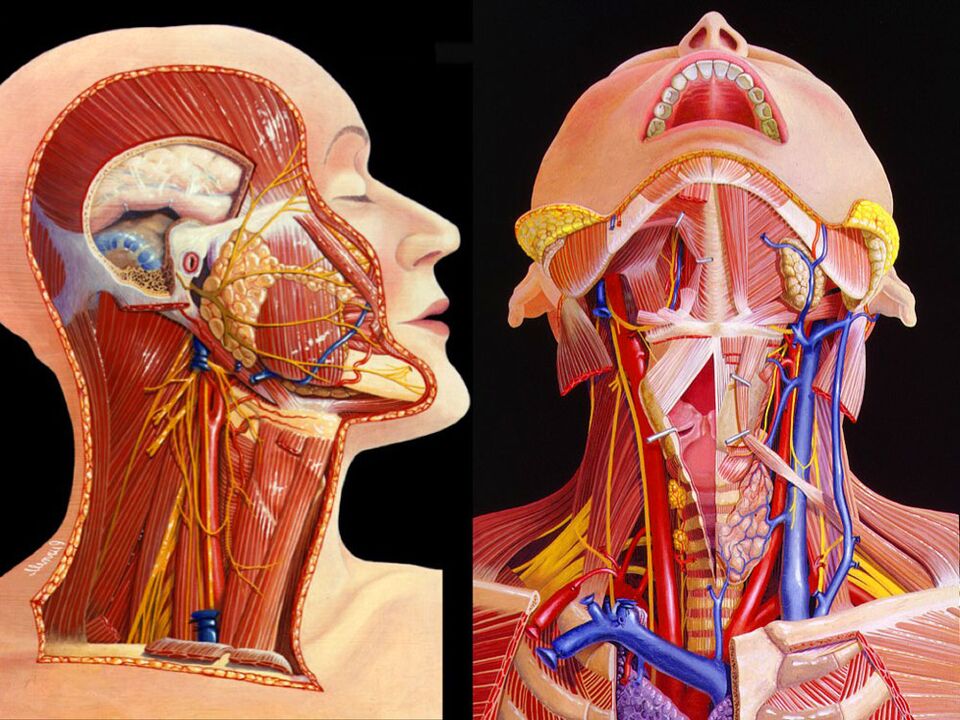
First Aid for Neck Pain – What to Do
Pills and Ointments for Neck Pain
- Take a sedative - panicking will only aggravate the situation; you can take: 20 soothing drops or tablets containing a solution of levomenthol isovalerate and menthol under your tongue; these not only soothe blood vessels but also dilate them, This helps reduce muscle spasms and associated pain; you can also take 1 – 2 tablets of valerian extract or any other sedative you have on hand.
- Take painkillers (optional).
- To relieve pain, you can use topical pain relievers: ointments, gels, patches.
Exercises for Neck Pain
- Starting Position (IP) – Lie on your back with your head on a flat pillow; press your head against the pillow until you count to 5; rest and repeat; perform 5 – 7 approaches;
- IP - Lie on your left side with your head on a flat pillow; raise your head and maintain this position until you count to five; rest briefly and then perform at least five approaches;
- IP - Lie on right side; repeat previous exercise on right side;
- IP – Lie prone with hands behind head; lift head, resist with hands; approach – 5 seconds, rest briefly, repeat 5 – 7 times.
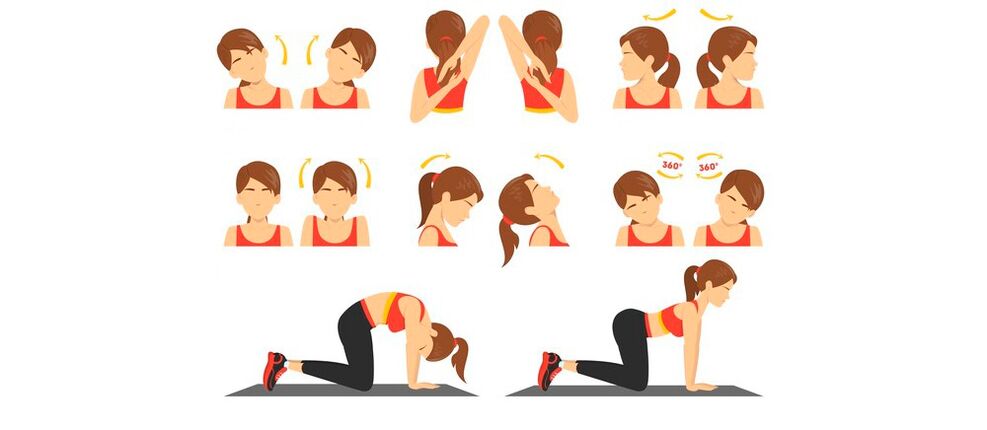
What not to do if you have neck pain
- Prolonged forced postures with neck tension - painful muscle spasms develop;
- Lifting heavy weights, doing strenuous work – microtrauma occurs to the spine and nearby tissues, and the cartilage and bone structure is gradually destroyed;
- Frequent exposure to stress - accompanied by vasospasm, which negatively affects blood circulation and spinal condition;
- Frequent smoking and drinking - leading to continued vasoconstriction;
- Hypothermia - inflammation of the muscles near the spine, myositis;
- Sleeping on a high, soft pillow means spending long periods of time in an uncomfortable static position;
- Turn your head suddenly - a nerve may be pinched suddenly and cause severe pain.
When you need to see a doctor urgently
- Neck pain occurs frequently and is not always fully relieved by painkillers;
- This is your first time experiencing a painful episode, or you have experienced it multiple times, and any movement causes severe pain;
- Pain syndrome is accompanied by general illnesses: fever, chills, etc. ;
- Sudden, brief, acute pain on the left side of the neck, radiating to the arm, shoulder blade or back of the head - this is a sign of acute circulatory disorder in the myocardial region (angina pectoris attack);
- Sudden onset of headache and dizziness, sometimes accompanied by loss of consciousness, is a sign of compression of the vertebral arteries.
Types of neck pain and how to deal with it
Severe neck pain caused by coronavirus and ARVI
severe neck pain and fever

- Exacerbation of a viral infection or some chronic inflammatory process (bronchitis, sinusitis, etc. ) - in this case, the disease is also accompanied by catarrhal symptoms - cough and runny nose; what to do: If the pain is not too severe, the temperature is alsoIf it is not high, you can wait to see a doctor; if pain persists after recovery, you should consult a doctor;
- Bacterial purulent inflammatory process - abscess, cellulitis; what to do: consult a surgeon, since symptoms can be eliminated only by surgery;
- Autoimmune process in the joints of the cervical spine; the first symptoms appear days or weeks after an acute inflammatory process, without catarrhal symptoms; What to do: consult a doctor immediately; self-medication is contraindicated.
Severe pain in the neck that radiates to the head
neck and shoulder injuries
Pain on the right or left side of your neck
- very strong sudden attack– Signs of invasion of the spinal cord roots on the right or left side; a lidocaine patch may help, but this is only a temporary measure and a neurologist needs to be contacted;
- Sudden paroxysmal brief but severe pain in the left side of the neck– May be symptoms of angina; if symptoms recur, you need to seek help from a therapist or cardiologist;
- Pain on the left or right side– due to neck muscle spasms, which often occur when the head is held under tension for a long time; to relieve spasms, use pain relief ointments and patches; when experiencing painful muscle spasms, you need to monitor your posture and avoid headWork involving prolonged periods of static stress.
severe back and neck pain
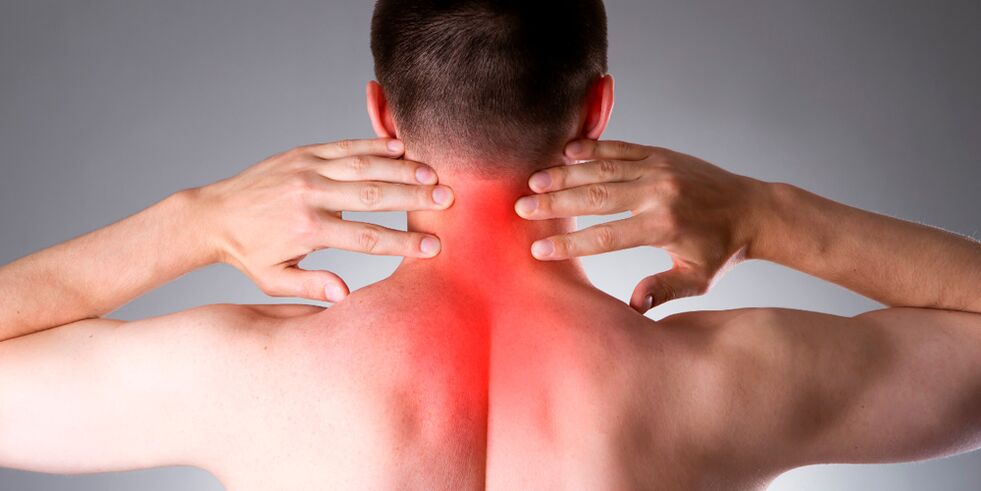
severe radiating pain in neck
- Suffering from inflammatory diseases of the ear, nose and throat organs - sore throat, chronic tonsillitis, laryngitis, pharyngitis; usually this is pain in the throat and ears, accompanied by symptoms such as fever, sore throat, cough; in the course of chronic inflammation, the condition does notSo acute, no fever, moderate pain;
- Degenerative dystrophic disease of the cervical spine (osteochondrosis) and its consequences - herniations and disc herniations; cervical pain syndromes associated with discs that protrude beyond the spine or overgrown vertebrae bone tissue that presses against the base of the spine; ear disease caused by osteochondrosisPain in the neck is a sign of nerve root compression at the third cervical vertebra (C3);
- Arthritis (inflammation) or arthropathy (metabolic disorder) at the facet joints C3 - C4 that connect the cervical vertebrae;
- Often associated with osteochondrosis - C3 – C4 vertebral injury;
- Have a reflective character; this is caused by dental problems: deep tooth decay and periodontitis in the outer part of the maxillary dentition; various malocclusions; pain can radiate from the mouth down to the neck, and there is often a feeling of being in the neckPain that radiates to the right or left tooth; What to do: Treat or remove damaged tooth to restore bite; Reflex pain syndrome may be related to arthritis or temporomandibular joint (TMJ) arthropathy - it seems youThe tooth is injured and the pain radiates to the neck;
severe pain in neck muscles
The back of my neck hurts
Throat pain in front of neck
Neck pain when turning or bending over
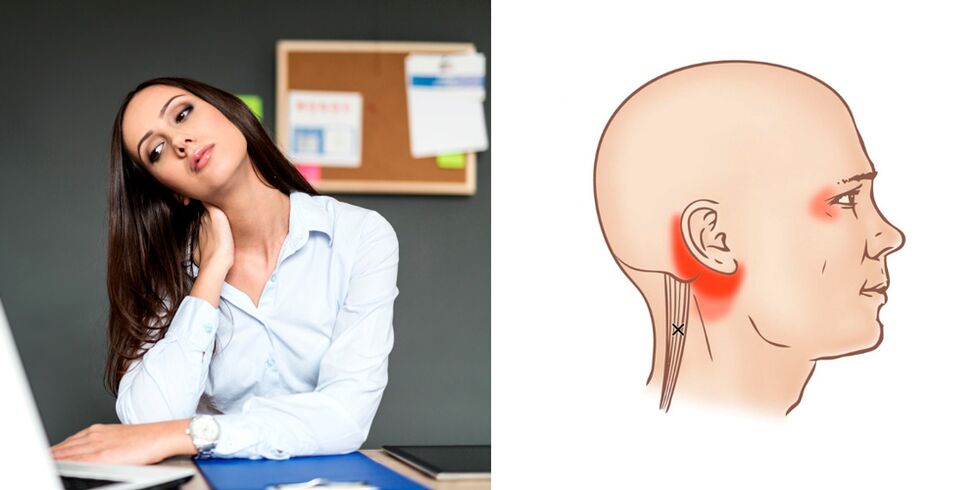
- Osteochondrosis and invasion of the roots of the spinal cord; pain syndrome severe and sudden, almost impossible to turn or tilt the head; What to do: See a neurologist urgently;
- Acute neck injury or long-term microtrauma; pain syndrome associated with neck muscle spasm and subsequent inflammation in the absence of skeletal changes (fractures, dislocations); What to do: Seek help from a neurologist;
- Curvature of the spine - scoliosis; pain is aching in nature and worsens when bending the neck; What to do: Contact an orthopedic traumatologist.
Neck pain after sleeping
Severe pain and crunching in the neck
Treat conditions that cause neck pain
diagnosis

- lab testing– General clinical, biochemical and immunological blood tests. The data obtained make it possible to identify inflammatory, metabolic and autoimmune processes.
- Instrument diagnostic methods:If necessary, take an X-ray of the affected part of the spine– shoulder joint;Soft tissue ultrasound;MRI or CT– A more detailed examination of the cervical area;Neuroelectromyography– Assess the condition of spinal nerve roots.
Ways to Treat Neck Pain















































